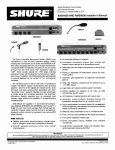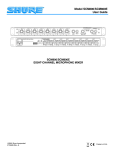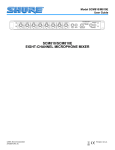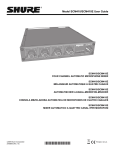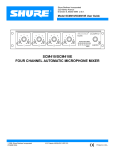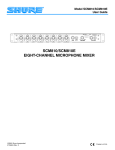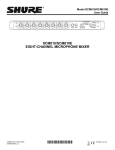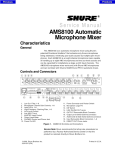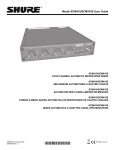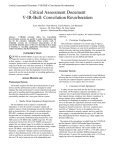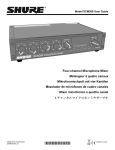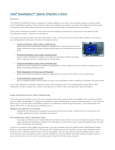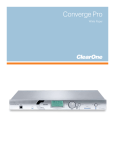Download Shure AMS28 User guide
Transcript
Model AMS8100 User Guide AMS8100 0 POW ER 0 +12 -30 -12 LIMITER OUTPUT 6 4 8 2 0 1 2 3 4 5 6 7 8 -∞ MASTER PHONES AUX AUTOMATIC MICROPHONE MIXER NOTE Shure AMS8100 Mixers are designed for use only with Shure AMS Condenser Microphones. Conventional condenser or other microphones will not operate properly with the AMS8100. 27C8621 (CD) ©2003 Shure Incorporated Printed in U.S.A. ! IMPORTANT SAFETY INSTRUCTIONS ! 1. 2. 3. 4. 5. 6. 7. 8. 9. 10. READ these instructions. KEEP these instructions. HEED all warnings. FOLLOW all instructions. DO NOT use this apparatus near water. CLEAN ONLY with dry cloth. DO NOT block any ventilation openings. Install in accordance with the manufacturer's instructions. DO NOT install near any heat sources such as radiators, heat registers, stoves, or other apparatus (including amplifiers) that produce heat. DO NOT defeat the safety purpose of the polarized or grounding-type plug. A polarized plug has two blades with one wider than the other. A grounding type plug has two blades and a third grounding prong. The wider blade or the third prong are provided for your safety. If the provided plug does not fit into your outlet, consult an electrician for replacement of the obsolete outlet. PROTECT the power cord from being walked on or pinched, particularly at plugs, convenience receptacles, and the point where they exit from the apparatus. 11. 12. 13. 14. 15. This symbol indicates that there are important operating and maintenance instructions in the literature accompanying this unit. ONLY USE attachments/accessories specified by the manufacturer. USE only with a cart, stand, tripod, bracket, or table specified by the manufacturer, or sold with the apparatus. When a cart is used, use caution when moving the cart/apparatus combination to avoid injury from tip-over. UNPLUG this apparatus during lightning storms or when unused for long periods of time. REFER all servicing to qualified service personnel. Servicing is required when the apparatus has been damaged in any way, such as power-supply cord or plug is damaged, liquid has been spilled or objects have fallen into the apparatus, the apparatus has been exposed to rain or moisture, does not operate normally, or has been dropped. DO NOT expose the apparatus to dripping and splashing. DO NOT put objects filled with liquids, such as vases, on the apparatus. This symbol indicates that dangerous voltage constituting a risk of electric shock is present within this unit. ! CONSIGNES DE SÉCURITÉ IMPORTANTES ! 1. 2. 3. 4. 5. 6. 7. 8. 9. LIRE ces consignes. CONSERVER ces consignes. OBSERVER tous les avertissements. SUIVRE toutes les consignes. NE PAS utiliser cet appareil à proximité de l'eau. NETTOYER UNIQUEMENT avec un chiffon sec. NE PAS obstruer les ouvertures de ventilation. Installer en respectant les consignes du fabricant. Ne pas installer à proximité d'une source de chaleur telle qu'un radiateur, une bouche de chaleur, un poêle ou d'autres appareils (dont les amplificateurs) produisant de la chaleur. NE PAS détériorer la sécurité de la fiche polarisée ou de la fiche de terre. Une fiche polarisée comporte deux lames dont l'une est plus large que l'autre. Une fiche de terre comporte deux lames et une troisième broche de mise à la terre. La lame la plus large ou la troisième broche assure la sécurité de l'utilisateur. Si la fiche fournie ne s'adapte pas à la prise électrique, demander à un électricien de remplacer la prise hors normes. 10. 11. 12. 13. 14. 15. Ce symbole indique que la documentation fournie avec l'appareil contient des instructions d'utilisation et d'entretien importantes. PROTÉGER le cordon d'alimentation afin que personne ne marche dessus et que rien ne le pince, en particulier au niveau des fiches, des prises de courant et du point de sortie de l'appareil. UTILISER UNIQUEMENT les accessoires spécifiés par le fabricant. UTILISER uniquement avec un chariot, un pied, un trépied, un support ou une table spécifié par le fabricant ou vendu avec l'appareil. Si un chariot est utilisé, déplacer l'ensemble chariot-appareil avec précaution afin de ne pas le renverser, ce qui pourrait entraîner des blessures. DÉBRANCHER l'appareil pendant les orages ou quand il ne sera pas utilisé pendant longtemps. CONFIER toute réparation à du personnel qualifié. Des réparations sont nécessaires si l'appareil est endommagé de quelque façon que ce soit, comme par exemple : cordon ou prise d'alimentation endommagé, liquide renversé ou objet tombé à l'intérieur de l'appareil, exposition de l'appareil à la pluie ou à l'humidité, appareil qui ne marche pas normalement ou que l'on a fait tomber. NE PAS exposer cet appareil aux égouttures et aux éclaboussements. NE PAS poser des objets contenant de l'eau, comme des vases, sur l'appareil. Ce symbole indique la présence d'une tension dangereuse dans l'appareil constituant un risque de choc électrique. ! WICHTIGE SICHERHEITSHINWEISE ! 1. 2. 3. 4. 5. 6. 7. 8. 9. 10. Diese Hinweise LESEN. Diese Hinweise AUFHEBEN. Alle Warnhinweise BEACHTEN. Alle Anweisungen BEFOLGEN. Dieses Gerät NICHT in der Nähe von Wasser verwenden. NUR mit einem sauberen Tuch REINIGEN. KEINE Lüftungsöffnungen verdecken. Gemäß den Anweisungen des Herstellers einbauen. Nicht in der Nähe von Wärmequellen, wie Heizkörpern, Raumheizungen, Herden oder anderen Geräten (einschließlich Verstärkern) installieren, die Wärme erzeugen. Die Schutzfunktion des Schukosteckers NICHT umgehen. Bei Steckern für die USA gibt es polarisierte Stecker, bei denen ein Leiter breiter als der andere ist; US-Stecker mit Erdung verfügen über einen dritten Schutzleiter. Bei diesen Steckerausführungen dient der breitere Leiter bzw. der Schutzleiter Ihrer Sicherheit. Wenn der mitgelieferte Stecker nicht in die Steckdose passt, einen Elektriker mit dem Austauschen der veralteten Steckdose beauftragen. VERHINDERN, dass das Netzkabel gequetscht oder darauf getreten wird, insbesondere im Bereich der Stecker, Netzsteckdosen und an der Austrittsstelle vom Gerät. 11. 12. 13. 14. 15. Dieses Symbol zeigt an, dass gefährliche Spannungswerte, die ein Stromschlagrisiko darstellen, innerhalb dieses Geräts auftreten. NUR das vom Hersteller angegebene Zubehör und entsprechende Zusatzgeräte verwenden. NUR in Verbindung mit einem vom Hersteller angegebenen oder mit dem Gerät verkauften Transportwagen, Stand, Stativ, Träger oder Tisch verwenden. Wenn ein Transportwagen verwendet wird, beim Verschieben der Transportwagen-GeräteEinheit vorsichtig vorgehen, um Verletzungen durch Umkippen Das Netzkabel dieses Geräts während Gewittern oder bei längeren Stillstandszeiten aus der Steckdose ABZIEHEN. Alle Reparatur- und Wartungsarbeiten von qualifiziertem Kundendienstpersonal DURCHFÜHREN LASSEN. Kundendienst ist erforderlich, wenn das Gerät auf irgendwelche Weise beschädigt wurde, z.B. wenn das Netzkabel oder der Netzstecker beschädigt wurden, wenn Flüssigkeiten in das Gerät verschüttet wurden oder Fremdkörper hineinfielen, wenn das Gerät Regen oder Feuchtigkeit ausgesetzt war, nicht normal funktioniert oder fallen gelassen wurde. Dieses Gerät vor Tropf- und Spritzwasser SCHÜTZEN. KEINE mit Wasser gefüllten Gegenstände wie zum Beispiel Vasen auf das Gerät STELLEN. Dieses Symbol zeigt an, dass das diesem Gerät beiliegende Handbuch wichtige Betriebs- und Wartungsanweisungen enthält. 2 ! INSTRUCCIONES IMPORTANTES DE SEGURIDAD ! 1. 2. 3. 4. 5. 6. 7. 8. 9. LEA estas instrucciones. CONSERVE estas instrucciones. PRESTE ATENCION a todas las advertencias. SIGA todas las instrucciones. NO utilice este aparato cerca del agua. LIMPIESE UNICAMENTE con un trapo seco. NO obstruya ninguna de las aberturas de ventilación. Instálese según lo indicado en las instrucciones del fabricante. No instale el aparato cerca de fuentes de calor tales como radiadores, registros de calefacción, estufas u otros aparatos (incluyendo amplificadores) que produzcan calor. NO anule la función de seguridad del enchufe polarizado o con clavija de puesta a tierra. Un enchufe polarizado tiene dos patas, una más ancha que la otra. Un enchufe con puesta a tierra tiene dos patas y una tercera clavija con puesta a tierra. La pata más ancha o la tercera clavija se proporciona para su seguridad. Si el tomacorriente no es del tipo apropiado para el enchufe, consulte a un electricista para que sustituya el tomacorriente de estilo anticuado. 10. 11. 12. 13. 14. 15. Este símbolo indica que la unidad contiene niveles de voltaje peligrosos que representan un riesgo de choques eléctricos. PROTEJA el cable eléctrico para evitar que personas lo pisen o estrujen, particularmente en sus enchufes, en los tomacorrientes y en el punto en el cual sale del aparato. UTILICE únicamente los accesorios especificados por el fabricante. UTILICESE únicamente con un carro, pedestal, trípode, escuadra o mesa del tipo especificado por el fabricante o vendido con el aparato. Si se usa un carro, el mismo debe moverse con sumo cuidado para evitar que se vuelque con el aparato. DESENCHUFE el aparato durante las tormentas eléctricas, o si no va a ser utilizado por un lapso prolongado. TODA reparación debe ser llevada a cabo por técnicos calificados. El aparato requiere reparación si ha sufrido cualquier tipo de daño, incluyendo los daños al cordón o enchufe eléctrico, si se derrama líquido sobre el aparato o si caen objetos en su interior, si ha sido expuesto a la lluvia o la humedad, si no funciona de modo normal, o si se ha caído. NO exponga este aparato a chorros o salpicaduras de líquidos. NO coloque objetos llenos con líquido, tales como floreros, sobre el aparato. Este símbolo indica que la literatura que acompaña a esta unidad contiene instrucciones importantes de funcionamiento y mantenimiento. ! ISTRUZIONI IMPORTANTI PER LA SICUREZZA ! 1. 2. 3. 4. 5. 6. 7. 8. 9. EGGETE queste istruzioni. CONSERVATE queste istruzioni. OSSERVATE tutte le avvertenze. SEGUITE tutte le istruzioni. NON usate questo apparecchio vicino all'acqua. PULITE l'apparecchio SOLO con un panno asciutto. NON ostruite alcuna apertura per l'aria di raffreddamento. Installate l'apparecchio seguendo le istruzioni del costruttore. NON installate l'apparecchio accanto a fonti di calore quali radiatori, aperture per l'efflusso di aria calda, forni o altri apparecchi (amplificatori inclusi) che generino calore. NON modificate la spina polarizzata o con spinotto di protezione. Una spina polarizzata è dotata di due lame, una più ampia dell'altra. Una spina con spinotto è dotata di due lame e di un terzo polo di messa a terra. La lama più ampia ed il terzo polo hanno lo scopo di tutelare la vostra incolumità. Se la spina in dotazione non si adatta alla presa di corrente, rivolgetevi ad un elettricista per far eseguire le modifiche necessarie. 10. 11. 12. 13. 14. 15. Questo simbolo indica la presenza di alta tensione all'interno dell'apparecchio, che comporta il rischio di folgorazione. EVITATE di calpestare il cavo di alimentazione o di comprimerlo, specie in corrispondenza di spine, prese di corrente e punto di uscita dall'apparecchio. USATE ESCLUSIVAMENTE i dispositivi di collegamento e gli accessori specificati dal costruttore. USATE l'apparecchio solo con carrelli, sostegni, treppiedi, staffe o tavoli specificati dal costruttore o venduti insieme all'apparecchio stesso. Se usate un carrello, fate attenzione durante gli spostamenti per evitare infortuni causati da un eventuale ribaltamento del carrello stesso. SCOLLEGATE l'apparecchio dalla presa di corrente in caso di temporali o di non utilizzo per un lungo periodo. RIVOLGETEVI a personale di assistenza qualificato per qualsiasi intervento. È necessario intervenire sull'apparecchio ogniqualvolta sia stato danneggiato, in qualsiasi modo, ad esempio in caso di danneggiamento di spina o cavo di alimentazione, versamento di liquido sull'apparecchio o caduta di oggetti su di esso, esposizione dell'apparecchio a pioggia o umidità, funzionamento irregolare o caduta. NON esponetelo a sgocciolamenti o spruzzi. NON appoggiate sull'apparecchio oggetti pieni di liquidi, ad esempio vasi da fiori. Questo simbolo indica la presenza di istruzioni importanti per l'uso e la manutenzione nella documentazione in dotazione all'apparecchio. 3 SHURE AMS8100 DESCRIPTION The AMS8100 is designed for numerous applications in sound reinforcement, audio recording, and broadcast. In any speech pickup application where multiple microphones are required, the AMS8100 dramatically improves audio quality. Automatic operation allows an individual talker’s voice to rise above background noise and reverberation to become clearer and more intelligible. The Shure Model AMS8100 is an automatic microphone mixer using Shure’s patent--pending Directional IntellimixÒ circuitry. Directional Intellimix activates only those microphones being addressed, minimizing the poor audio caused by multiple open microphones. The special patented* AMS microphones gate on only for sounds arriving from in front of the microphone within a 120_ “acceptance angle”. Additionally, if a talker’s voice originates within the acceptance angle of more than one AMS microphone, Directional Intellimix will activate only the closest, loudest microphone. Directional Intellimix, however, does not limit the number of open microphones to one; if several talkers speak simultaneously, Directional Intellimix will activate several microphones. The AMS8100 can handle up to eight AMS microphones and two aux--level sources. The AMS8100 microphone inputs work only with Shure AMS microphones. Each microphone input channel has a two-band equalizer. Equalization is useful to reduce unwanted low-frequency audio pickup, as well as to make the different AMS microphones—lavalier, surface-mount, probe and gooseneck—sound similar in their different applications. Each input channel has three associated logic terminals: Gate Out, Mute In, and Override In. These connections provide for activation of external devices and external microphone control, important for specialized installed sound applications. Each mixer channel also has a 1/4-inch phone jack for use as a direct output. This jack can be modified to be a gated channel output or a send/receive insert point. The AMS8100 is capable of being expanded for installations as large as 400 input channels. The AMS8100 is fully link--compatible with Shure’s SCM810 and FP410 automatic mixers. The single-rack-height chassis is ideal for installations with limited rack space. The removable header-type input and output connectors are quick, convenient, and eliminate the time and expense of wiring XLR microphone connectors. The AMS8100 is designed for 100--120 Vac operation and its line cord contains a standard American 3-pin grounded ac plug. The AMS8100E is designed for 220--240 Vac operation and its line cord contains a CEE 7/7 (“Schuko”) plug. An accessory rack panel adapter to convert the removable block input and output connectors to XLR connectors, and aux connectors to phono jacks is available as the RKC800. FEATURES · Reliable, quick-acting, noise-free microphone activation · Quick setup -- no threshold settings to adjust · Direction--sensitive gating activates microphones only for sounds originating within 120_ acceptance angle · MaxBus allows gating of only one microphone per talker, while allowing gating of multiple microphones for multiple talkers · Last Mic Lock-On circuit maintains ambient sound · Automatic gain reduction as additional microphones are activated (NOMA: Number of Open Microphones Attenuator) · Adjustable EQ per channel: low-frequency rolloff and highfrequency shelving · Bi-color LED indication of channel activation and clipping · Removable block screw connectors for quick and easy connection of microphones · Link--compatible with SCM810 and FP410 automatic mixers · Linking capability for systems up to 400 microphones · Non-automatic aux-level inputs with level control · Front-panel headphone output with level control · Peak-responding output limiter with selectable thresholds and LED indicator · 100--120 V operation or 220--240 V operation, selectable via internal switch. · AMS8100: UL and cUL listed under UL813 and CSA C22.2 No. 1. · AMS8100E: Conforms to European Union directives, eligible to bear CE marking; VDE GS-Certified to EN 60 065; meets European Union EMC Immunity Requirements (EN 50 082--1, 1992). NOTE Shure AMS8100 Mixers are designed for use only with Shure AMS Condenser Microphones. Conventional condenser or other microphones will not operate properly with the AMS8100. *U.S. Patent #4,489,442 English -- 5 CONTENTS Description . . . . . . . . . . . . . . . . . . . . . . . . . . . . . . . . . . . . . . . . . . . . . . . . . . . . . . . . . . . . . . . . . . . . . . . . . . . . . . . . . . . . 5 Features . . . . . . . . . . . . . . . . . . . . . . . . . . . . . . . . . . . . . . . . . . . . . . . . . . . . . . . . . . . . . . . . . . . . . . . . . . . . . . . . . . . . . . . 5 Contents . . . . . . . . . . . . . . . . . . . . . . . . . . . . . . . . . . . . . . . . . . . . . . . . . . . . . . . . . . . . . . . . . . . . . . . . . . . . . . . . . . . . . . . 6 Operating Principles . . . . . . . . . . . . . . . . . . . . . . . . . . . . . . . . . . . . . . . . . . . . . . . . . . . . . . . . . . . . . . . . . . . . . . . . . . . . 7 Front Panel . . . . . . . . . . . . . . . . . . . . . . . . . . . . . . . . . . . . . . . . . . . . . . . . . . . . . . . . . . . . . . . . . . . . . . . . . . . . . . . . . . . . 8 Rear Panel . . . . . . . . . . . . . . . . . . . . . . . . . . . . . . . . . . . . . . . . . . . . . . . . . . . . . . . . . . . . . . . . . . . . . . . . . . . . . . . . . . . . . 9 AMS Microphones . . . . . . . . . . . . . . . . . . . . . . . . . . . . . . . . . . . . . . . . . . . . . . . . . . . . . . . . . . . . . . . . . . . . . . . . . . . . . 10 Dip Switches . . . . . . . . . . . . . . . . . . . . . . . . . . . . . . . . . . . . . . . . . . . . . . . . . . . . . . . . . . . . . . . . . . . . . . . . . . . . . . . . . . 11 Setup . . . . . . . . . . . . . . . . . . . . . . . . . . . . . . . . . . . . . . . . . . . . . . . . . . . . . . . . . . . . . . . . . . . . . . . . . . . . . . . . . . . . . . . . . 12 Mixer Linking . . . . . . . . . . . . . . . . . . . . . . . . . . . . . . . . . . . . . . . . . . . . . . . . . . . . . . . . . . . . . . . . . . . . . . . . . . . . . . . . . . 14 Specifications . . . . . . . . . . . . . . . . . . . . . . . . . . . . . . . . . . . . . . . . . . . . . . . . . . . . . . . . . . . . . . . . . . . . . . . . . . . . . . . . . 16 Advanced Functions . . . . . . . . . . . . . . . . . . . . . . . . . . . . . . . . . . . . . . . . . . . . . . . . . . . . . . . . . . . . . . . . . . . . . . . . . . . 17 English -- 6 OPERATING PRINCIPLES The AMS8100 is designed for use in a wide variety of multiple microphone speech applications. It is an audio processor that activates only the microphones that are being addressed. The operational concept behind the AMS8100 is called Directional IntelliMixÒ. It delivers seamless automatic mixing via a unique combination of features: · AMS direction--sensitive microphones · MaxBus · Last Mic Lock-On · NOMA An AMS direction--sensitive microphone will activate only for sounds which originate within a 120_ acceptance angle in front of the microphone. Other sounds outside of the 120_ acceptance angle, including speech, background noise, and reverberation, will not gate the microphone on, regardless of level. MaxBus eliminates the poor audio quality that results when a talker is picked up by more than one microphone. It does this by controlling the number of microphones that may activate for a single sound source. With MaxBus, one talker will activate only one AMS8100 channel, even if multiple microphones are “hearing” that talker. However, Maxbus allows multiple channels to activate simultaneously for multiple talkers. See the illustrations below. The illustration on the left shows how an AMS4000 or AMS8000 gates microphones for two talkers — by automatically gating on any microphones that pick up a talker within the 120_ acceptance angle. The illustration on the right shows how MaxBus operates in the AMS8100 —even though the talkers are within the acceptance angle of several microphones, only one microphone will activate for each talker. Last Mic Lock-On maintains a seamless audio mix by keeping the most recently activated microphone open until a newly activated microphone takes its place. Without Last Mic Lock-On, a long pause in conversation will cause all microphones to turn off, and it may sound as if the audio signal has been lost. Last Mic Lock-On ensures that background ambiance will always be present. (This feature can be defeated via DIP switch on the rear panel.) WITHOUT MaxBus (AMS8000) NOMA (Number of Open Microphones Attenuator) automatically reduces the gain of the mixer as additional microphones are activated. In a sound reinforcement application, if the system gain is set below the feedback point with a single microphone gated on, the increase in system gain with additional “on” microphones could cause feedback. NOMA prevents this by automatically reducing all “on” microphone gains by 3 dB as additional microphones are gated on. This maintains constant total system gain, avoiding feedback and permitting the maximum microphone gains at all times. Also, this consistency of system gain means that pickup of room noise and reverberation also remains constant at the level of a single microphone. (Note: NOMA is not the same as an automatic gain control [AGC] and does not adjust input levels based on loud or soft talking.) Multiple miking situations—with several talkers participating—have always presented problems for the audio technician. If too few mics are used, the coverage of each talker may vary, with one talker (nearest the mic) being louder and clearer than the next. Talkers farthest from the mics will sound “echoey” and reverberant, as very little of their direct sound reaches the microphones. If too many mics are used, there’s more background noise and reverberation pickup, as well as less gain before feedback with a sound reinforcement (PA) system. It’s similar to having multiple video cameras all focused on the same subject. If these camera signals are combined, the result is a blurred image. When multiple microphones are open for a single talker, the result is a blurred audio signal. It’s often not practical for someone to turn mics on when they are needed and off when they are not. The AMS8100 automatic microphone mixer solves these problems. The AMS8100 automatically attenuates (turns down) any microphone not being used, greatly reducing the excess reverberation and feedback problems associated with the use of conventional multiple microphone and mixer techniques. When a new talker starts to speak, the AMS8100 immediately selects and silently activates the most appropriate microphone within 4 milliseconds. Directional IntelliMix signal processing enables the AMS8100 to provide clear, natural voice pickup. The AMS8100 significantly reduces the problems of “hollow” or “muddy” sound, and insufficient gain before feedback. *Shaded areas indicate microphones gating on. English -- 7 WITH MaxBus (AMS8100) FRONT PANEL Î Ê Ë Ð Ñ Ó AMS8100 4 2 8 0 Ì 4 6 1 10 6 2 4 8 0 2 10 4 6 2 8 0 3 10 6 2 4 8 0 4 10 6 2 4 8 0 5 10 6 2 8 0 6 10 6 2 4 8 0 7 10 Í 6 2 LIMITER 8 0 8 10 Microphone Channel Gain Controls 1 - 8. Allows adjustment of microphone gain. Ë Input LED 1 - 8. Lights green when channel is active; lights red at 6 dB below clipping level. Ì Low-Cut Filter 1 - 8. Recessed screwdriver adjustment provides adjustable low-frequency rolloff (high pass) to reduce undesirable low-frequency signals. Í High-Frequency Shelving Filter 1 - 8. Recessed screwdriver adjustment provides level boost or cut in mid/highfrequency region for compensation of off-axis microphones, or for cutting the high-frequency sibilance of microphones. AUX Level Control. Sets the input level for aux-level equipment connected to the adjacent 1/4-inch phone jack INPUT or rear-panel 1/4-inch AUX input. POWER -30 -12 0 +12 AUX Ï Ê Î 4 INPUT +20 MASTER PHONES Ò Ï Aux INPUT 1/4-inch Phone Jack. Mixes external auxiliary- or line-level sources, i.e., tape recorders, into output. This input is not automatic. Signal appears at output of all linked mixers. Unbalanced input: Tip = input, Ring = input. Tip and Ring sum together. Ð MASTER Level Control. Determines the overall output level. Ñ Output Level Meter. Nine-segment LED meter indicates peak output signal level. Last LED indicates limiter action. Ò PHONES Control and 1/4-inch Phone Jack. Permits monitoring of mixer output through headphones. PHONES control determines headphone output level. Ó POWER LED. Lights green when unit is powered. English -- 8 REAR PANEL Ê Ë Ì Ï Í Ê Ë Ò Î Ñ Power Connector and Rocker Switch. Switch turns unit on when power cord is plugged into AC mains. Can be internally switched for 100--120 Vac or 220--240 Vac operation (see Voltage Selection). Ï OUTPUT LEVEL Switch. Switches between +4 dBu (line), --10 dBV (aux), and mic level output. Switch is located behind OUTPUT connector. Ð DIRECT OUT 1/4-inch Phone Jacks. Provides nongated aux-level signal from each channel. Direct outs are wired pre-fader and pre-EQ. Can be modified for use as a gated channel output, or a send/receive insert point. (see Internal Modifications). Microphone Logic. DB-25 male connector provides connection to each channel’s logic terminals. GATE OUT, MUTE IN, and OVERRIDE IN logic terminals are available for each channel. Logic allows the AMS8100 to perform additional functions, such as cough buttons and remote LED status indicators (see Suggested Logic Applications). NOTE: THIS IS NOT AN RS-232 PORT. Ì DIP Switch. The 7-position DIP switch provides setup options for the mixer (see DIP Switches). Í LINK IN/OUT Jacks. Permit multiple AMS8100, SCM810, or FP410 mixers to be stacked for additional inputs. Up to 50 AMS8100 mixers can be linked. For linking to AMS8000 or AMS4000, see Mixer Linking. Î OUTPUT Removable Block Connector. Active balanced output signal for connection to amplifiers, recorders or other mixers. Pin 1 = hot (+), Pin 2 = cold (--), Pin 3 = ground. If connecting to an unbalanced input, connect pin 2 (--) to pin 3 (ground). Ð As Direct out: Unbalanced Tip = output Ring = not connected Sleeve = ground. As AUX input:(channel 8 only): Unbalanced Tip = input Ring = input Tip and Ring sum together. Ñ INPUT 1--8 Removable Block Connectors: For connection to AMS microphones only. Pin 1 = front cartridge (red wire), Pin 2 = rear cartridge (black wire), Pin 3= ground (shield). Ò AUX/D.O./D.O. 3-Position Slide Switch. Selects either aux input function or direct output function for channel 8 (only) Direct Out jack. Left switch position is AUX IN; center and right positions are DIRECT OUT. Switch is located behind Channel 8 Input connector. English -- 9 AMS MICROPHONES Description AMS Microphones are gated on only by sounds which come from within the 120° acceptance angle. Sounds which reach the microphone from outside of that range, including background noise, will not turn the microphone on no matter how loud they are. See the illustrations below. When an AMS microphone is directed so a talker is within the 120° acceptance angle, the microphone will trigger on when that talker speaks. Since the microphone is not triggered by sounds from outside of that angle, the sound is clearer than that of conventional sound reinforcement systems. When a microphone is on, it operates as a cardioid microphone, or as a hemi--cardioid in the case of the AMS22 low--profile microphones. AMS microphones come in several models. Model AMS22 is a low-profile surface--mount microphone. Model AMS24 is a gooseneck microphone. Model AMS26 is a probe microphone with a front pop-filter grille. Model AMS28 is a lavalier microphone. XLR built in and a cable (as shown below) must be used to connect it to the AMS8100. This same type of cable can be used as an extension cable between the AMS22 or AMS28 microphones and the AMS8100 mixer. Under most circumstances, lengths of 150 meters (500 ft) or greater of high quality, 2-conductor, shielded microphone cable can be used between the microphone and the AMS mixer microphone input. The shield must be connected to both ends of the cables. Good practice dictates that microphones and cables be grounded only to the AMS mixer chassis ground (pin 3 of the input connector). Do not attempt to connect AMS microphones to standard phantom-powered inputs; they will not function properly. Placement Connections Use low--profile AMS22 boundary microphones on tables and desks; use permanently mounted AMS24 gooseneck microphones on tables, desks, or lecterns; use AMS26 probe microphones on floor or desk stands, or goosenecks; use AMS28 lavalier microphones where the talker must have freedom of movement. The AMS8100 utilizes removable block connectors for connecting the microphones. The AMS4000 and AMS8000 utilize XLR connectors for microphone connection. The newer block-style, screw connectors offer faster and more convenient connection than soldering XLR connectors. Locate the microphones so that intended sources are within 60° of either side of the front of the microphone; that is, within the 120° acceptance angle angle (see illustrations below). Sources of undesired sound should be located outside the 120° acceptance angle. The AMS22 and the AMS28 come supplied with XLR connectors already attached. Three options are available for connecting these microphones to the AMS8100. First, you can cut off the XLR connector from the microphone cable, strip the individual wires, then slip them into the supplied block connectors. Second, the Shure RKC800 (purchased separately) can be used to adapt up to eight (8) XLR connectors to pre-wired block connectors suitable for the AMS8100. Third, an extension cable (as shown below) can be used to connect an AMS microphone. The closer the microphones are to their sound sources, the greater the loudness of the sound system before feedback occurs. Likewise, the farther the microphones are from loudspeakers, the louder the sound system can get before feedback occurs. These distances have a well-defined effect on system gain before feedback, as described by the Potential Acoustic Gain (PAG) equation. For more information on the PAG equation, contact Shure’s Applications Group at 847--866--2525. The AMS24 gooseneck microphone is supplied without an XLR connector, and can be wired directly to the block connector. The AMS26 is a probe-style microphone which has an Sound reflections from a hard surface can hamper proper gating. Each microphone should be at least 1 meter (3 ft) from the wall behind it, and at least 0.3 meters (1 ft) from objects behind it, such as briefcases. AMS24 120 o AMS26 AMS22 AMS28 PIN 2 + (RED) PIN 1 (SHIELD) PIN 2 -(BLACK) PIN 1 + (RED) + TO AMS MICROPHONE PIN 3 -(BLACK) XLR TO BLOCK CONNECTOR English --10 PIN 3 SHIELD -- AMS MICROPHONE INPUT DIP SWITCHES The rear-panel DIP switch provides the following setup options. The positions shown in bold type are the factory settings. (MIXER REAR PANEL) NOTE: Switch positions and effects are shown in the illustration below and also on the mixer label. DIP SWITCH SW902 1 2 3 4 5 6 7 DIP SWITCH SW902 FUNCTIONS Switch Function Manual/Auto Last Mic Lock-On Hold Time Off-Attenuation Level Limiter Threshold Link Local/Global Switch Position Number® 1 2 3 4 5,6 7 5 Up 6 Up 5 Down 6 Up Switch Up Auto On 0.4 second 15 dB 5 Up 6 Down 5 Down 6 Down Switch Down Manual All mics off after hold time ¥ (completely 1.0 second off) Manual/Auto: Automatic activation is defeated in the Manual position. In Manual mode, the AMS8100 functions as a standard 8x1 mixer. Last Mic Lock-On: Last Mic Lock-On feature keeps the most recently activated microphone turned on until a newly activated microphone takes its place. When defeated, microphones turn off after their preset hold time. Hold Time: Adjusts the time an activated microphone (which is not locked on) remains on after the talker stops talking. Settings are 0.4 seconds or 1.0 second. = Limiter off = +8 dBu Global = +16 dBu = +4 dBu Local Off-Attenuation: Changes the off-attenuation level from 15 dB to infinity (¥). With the 15 dB setting, an unused microphone is 15 dB lower in level than when it is activated. With the ¥ setting, an unused microphone is completely off. Limiter Threshold: Changes the output limiter threshold. Settings are OFF (factory setting), +16 dBu, +8 dBu, or +4 dBu (see Internal Modifications for other threshold settings). Link Global/Local: Determines whether each linked AMS8100 output contains only its own program output, or that of all linked mixers (see Mixer Linking for more information). English --11 SETUP MOUNTING To mount the AMS8100 in a rack-mount in a standard 19-inch audio equipment rack, install the mixer using the sup- plied Phillips head screws through each side panel. Use all four screws. CONNECTIONS Make audio connections as follows: 3. If additional AMS8100 mixers are to be linked to increase the number of microphone inputs, connect them by means of the Link In and Link Out jacks. Connect the LINK OUT of the first mixer to the LINK IN of the next mixer, and so on. Leave the LINK IN jack of the first mixer and the LINK OUT jack of the last mixer unconnected. NOTE: These jacks are for linking only, not for audio inputs or outputs (see Figure 5). TO STEREO OR MONO HEADPHONES FROM AUX-- OR LINE--LEVEL SOURCE TO AMP/REC/MIXER INPUT (CH. 1--7) FROM AMS MICS (CH. 1--8) TO AMP/RECORD/MIXER INPUT OR FROM AUX SOURCE (CH. 8) MIXER OUTPUT TO AMP/REC/MIXER INPUT TO LINKED AMS8100 MIXERS TO ADVANCED FUNCTION WIRING TO AC POWER SOURCE AUDIO CONNECTIONS 1. Connect an AMS microphone to the Channel Input connectors (use high-quality 2-conductor shielded cables). It is important to connect the red wire from the AMS microphone cable to the first pin of the block connector, the black wire to the second pin of the block connector, and the shield to the last pin of the block connector. 2. Connect the AMS8100 Line Level Output to the input of mixers, EQs, amplifiers or recorders. LINKING MIXERS 4. For headphone monitoring, connect headphones to the front-panel 1/4-inch PHONES jack. 5. Connect the power cord to the appropriate power source. If the operating voltage is to be changed, refer to the Voltage Selection section. CONTROL SETTINGS 1. Turn on the Power switch. 2. Adjust each channel level so that its Overload LED flickers only during very loud speech. 3. Adjust the Low-Cut and High-Frequency controls adjacent to each Input Gain control to make each microphone sound similar. 4. Adjust the AMS8100 Master level control for the required output level, as indicated by the output peak meter. 5. Adjust the headphone volume level with the PHONES control knob. 6. The AMS8100 is now ready for operation. English --12 EQUALIZER Low Cut Filter (High-Pass) +2 The low-cut (or high-pass) filter allows all frequencies above its cutoff point to pass from filter input to filter output without attenuation, while frequencies below the cutoff are attenuated (see right). The cutoff point is defined as the frequency where the signal has dropped 3 dB relative to the flat, or bandpass, region. Below the cutoff point, the filter exhibits increasingly more attenuation as the frequency diminishes. The AMS8100 has an adjustable-frequency, low-cut (high-pass) filter of 6 dB per octave. Low-cut filters are ideally used for attenuating, or rolling off, the audio signal where extraneous noise, excessive proximity effect, or other unwanted material is present. For example, the low-frequency vibration cause by footsteps and vehicle traffic can be transmitted through microphone stands to the microphone, and then into the sound system. These frequencies, typically ranging from 5 to 80 Hz, are generally not desirable. FULL CW 0 -2 -4 -6 FULL CCW -8 -10 20 100 50% ROTATION 1,000 5,000 FREQUENCY (Hz) LOW-CUT FILTER EFFECTS +10 FULL CW +8 +6 +4 +2 High-Frequency Shelving The fixed-frequency equalizer produces a 6 dB boost or cut at 5 kHz and above (see right). High-frequency shelving is extremely useful for boosting flat frequency response, tempering very sibilant vocal microphones, or enhancing the sound of off-axis lavalier microphones. 50% ROTATION 0 -2 -4 -6 -8 -10 200 FULL CCW 1,000 FREQUENCY (Hz) 10,000 20,000 HIGH-FREQUENCY SHELVING EFFECTS LIMITER The AMS8100 has a peak output limiter that prevents distortion during loud program peaks without affecting normal program levels. Increasing the individual or Master level controls will increase the average output and, in turn, the amount of limiting. A limiter prevents excessive overloading of devices connected to the AMS8100 output. As supplied, the limiter is defeated. The limiter threshold is selectable for a peak output level of +4, +8, or +16 dBu. For instance, with the threshold set at +16 dBu, the mixer would have 12 dB of headroom with a nominal level of +4 dBu. The limiter thresholds can be changed from their factory settings as described in the Internal Modifications section. USING AN EQUALIZER/FEEDBACK CONTROLLER WITH AN AUTOMATIC MIXER When setting up a sound system which has an outboard equalizer or feedback controller in the signal chain, set the AMS8100 to MANUAL. This activates all microphone inputs, so every possible feedback path is open. With the AMS8100 in MANUAL mode, equalize the sound system and/or “Ring Out” the room to set the feedback controller. After equalization is complete, set the AMS8100 to AUTOMATIC mode. Remember that the input of an automatic mixer drops by 3 dB every time the number activated inputs doubles. When using an AMS8100 in MANUAL mode, the master output drops by 9 dB when all 8 inputs are activated. Conversely, it will rise by 9 dB when switched back to AUTOMATIC mode. English --13 MIXER LINKING Linking Multiple AMS8100 Mixers Linking an AMS8100 to AMS8000/AMS4000 The AMS8100 provides eight input channels. If additional inputs are needed, more AMS8100 mixers (as many as 50) can be “linked” using supplied link cables. A setup like this can provide up to 400 mic inputs. To link the AMS8100 with AMS8000 or AMS4000 mixers, a special cable must be constructed by the installer (see below). Use high quality, 2-conductor, shielded cable. It is important to connect the mini-DIN connector to the AMS8100’s LINK IN and the 1/4-in. connectors to the AMS8000 or AMS4000 LINK OUT connector. When linked, the last--mic lock--on and MaxBus will function on the AMS8100, but not the AMS8000/AMS4000, as the AMS8000/AMS4000 do not contain circuitry for these functions. The direction--sensitive gating and the NOMA functions will be unaffected and work between linked mixers as before. As long as the link jacks of all mixers are connected (outto-in, sequentially, leaving one Link In and one Link Out jack unconnected), the automatic mixing functions will be shared by all units. All input signals appear at all linked mixer outputs. There is no master/slave relationship. The output controls and functions of each linked mixer are post-link and do not affect the signals appearing at other linked mixer outputs. Each mixer’s Master level control only controls its own output. Each output can be used independently. NOTE: The actual off-attenuation in the 15 dB switch position increases slightly as more mixers are linked. This reduces excessive noise and reverberation contributed by the increased number of attenuated microphones. In a linked system, the Aux input of any mixer appears at each linked mixer’s output. See Internal Modifications to defeat the linking of Aux signals. IMPORTANT: When using the logic terminals on linked mixers, connect the Channel 8 LOGIC GROUND terminals of each unit together. Switching clicks may result if this is not done. Linking AMS8100 to Shure SCM810 or FP410 The AMS8100 is fully link--compatible with Shure mixers utilizing Intellimix, such as the SCM810 or the FP410. When linked, the last--mic lock--on, MaxBus, and NOMA will work seamlessly with the other mixers. The direction--sensitive gating portion of the AMS8100 will function with its microphones, and the Noise Adaptive Threshold portion of the Intellimix mixer will function with the microphones connected to it. Room Combining To connect and disconnect two AMS8100s for room combining purposes, such as may be needed in a partitioned room, switches or relays must be inserted in series with the link cable conductors. To accomplish this, all eight conductors within the link cable must be independently switched, each with a SPST switch or relay. Alternatively, an 8PST switch or relay may be used. When the switch is closed, the mixers will be actively linked. When it is open, the mixers will operate independently. Extended Link Cables As the link connections in the AMS8100 are unbalanced, care must be taken when using longer link cables to avoid hum and noise problems. High quality, shielded cable should be used and the cables should be kept away from sources of magnetic or electrical noise, such as large power transformers or light dimmers. Additionally, linked mixers should be powered from the same AC mains circuit to minimize ground currents. These factors determine the maximum cable length, but cables under 2 m (6 ft) are generally not a problem. TIP LINK B TO LINK B OUT PIN 7 SLEEVE TO LINK IN AMS8100 PIN 5 LINK A PIN 1 TIP GROUND/SHIELD CABLE FOR LINKING AMS8100 MIXER TO AMS8000/AMS400 MIXER English --14 SLEEVE TO LINK OUT AMS8000 TO LINK A OUT GLOBAL/LOCAL FUNCTIONS The Global/Local switch selects which input channels appear at that linked mixer’s output. Set to the Global position, all input channels from all linked mixers appear at that mixer’s output. Set to the Local position, only its own eight input channels appear at that mixer’s output. The Master level control, in any mode, only controls the level of its own output. The Master level control is independent of the Global/Local switch. The output level of each mixer is affected only by its own Master control. All automatic functions (such as Last Mic Lock-on and MaxBus) are connected on all linked mixers and are not affected by the Global/Local switch. AMS8100 “C” (GLOBAL) LINK An example of the possibilities of this setup is shown in Figure 8. Here two AMS8100s are set to Local, and the resulting sound distribution provides local sound reinforcement while avoiding feedback. This is a simple “mix-minus” setup. The third AMS8100 is set to Global and feeds a tape recorder, At the same time, the automatic functions (Last Mic Lock-On, etc.) remain common to all mixers. The following table summarizes the mixer settings. Mixer Link Global/ Local Switch Audio Output Contains... A Local A B Local B C Global A, B, C RECORDER AMS8100 “A” (LOCAL) AMS8100 “B” (LOCAL) LOUDSPEAKER LOUDSPEAKER LINKED AMS8100 MIXERS English --15 SPECIFICATIONS Measurement Conditions (unless otherwise specified): full gain; 1 kHz, one channel activated; with AMS26 microphone; terminations: Line 10 kW, Phones 300 W (tip-sleeve and ring-sleeve), Direct Out 10 kW; Auto mode, equalization controls adjusted for flat response Frequency Response (Ref 1 kHz, channel controls centered) 80 Hz to 20 kHz ±2 dB; -3 dB corner at 50 Hz Voltage Gain (typical, controls full clockwise) Input Mic Aux AMS26 mic (72 dB SPL in) Aux --20 dBu 4 dB Send/Return --20 dB +5 dBu 29 dB 5 dB Inputs Input Output Line Headphone +20 — dBu 44 52 dB dB 20 28 dB dB Impedance Designed Actual for use (typical) with Direct Out --38 dBu — — Input Clipping Level Mic AMS Mics only 400 W Aux £2 kW £2 kW 10 kW +132 dB SPL +24 dBu 100 kW +20 dBu Send/Return Outputs Output Impedance Designed Actual for use (typical) with Output Clipping Level Line ³600 W 60 W +24 dBu Headphone 8-200 W, 60 W recommended 1 kW +6 dBu Direct Out >2 kW 1 kW +18 dBu Send/Re>2 kW 1 kW +18 dBu turn Total Harmonic Distortion <0.1% at +18 dBu output level, 80 Hz to 20 kHz (through 80 Hz-20 kHz filter; Input 1 and Master at 5, all other controls full counterclockwise) Hum and Noise Equivalent Input Noise . . . . . . . . . 27 dB SPL (A-weighted) Output Hum and Noise (through 20 Hz to 20 kHz filter; channel controls full counterclockwise) Master full counterclockwise . . . . . . . . . . . . . . . -90 dBu Master full clockwise . . . . . . . . . . . . . . . . . . . . . . -65 dBu Polarity Positive pressure on AMS microphone diaphragm produces positive voltage on pin 1 (+) with respect to pin 2 (--) at Output. Send inputs to all outputs are non-inverting. AUX input to all outputs is inverting. Input Channel Activation Attack Time . . . . . . . . . . . . . . . . . . . . . . . . . . . . . . . . . . . 4 ms Hold Time . . . . . . . . . . . . . . . . . . . 0.4 s (switchable to 1.0 s) Decay Time . . . . . . . . . . . . . . . . . . . . . . . . . . . . . . . . . . . 0.5 s Off-Attenuation 15 dB (switchable to ¥) Overload and Shorting Protection Shorting outputs, even for prolonged periods, causes no damage. Microphone inputs are not damaged by signals up to 3 V; Line and Monitor inputs by signals up to 20 V. Equalization Low-frequency . . . . . . . . . . . . . . 6 dB/octave cut, adjustable corner from 50 to 300 Hz High-frequency . . . . . . . . . . . . . . . . ±6 dB at 5 kHz, ±8 dB at 10 kHz, shelving Limiter Type . . . . . . . . . . . . . . . . . . . . . . . . . . . . . . . . . . . . . . . . . Peak Threshold . . . . . . . . . . . . . . . . . Switchable: off, +4, +8, +16 (dBu at output) Attack Time . . . . . . . . . . . . . . . . . . . . . . . . . . . . . . . . . . . 2 ms Recovery Time . . . . . . . . . . . . . . . . . . . . . . . . . . . . . . . 300 ms Indicator . . . . . . . . . . . . . . . . Lights red when limiting occurs Input LEDs Green on channel activation, red at 6 dB below clipping Operating Voltage AMS8100: 100--120 Vac, 50/60 Hz, 200 mA AMS8100E: 220--240 Vac, 50/60 Hz, 100 mA Temperature Range Operating . . . . . . . . . . . . . . 0° to 60° C (32° to 135° F ) Storage . . . . . . . . . . . . . . . . -30° to 70° C (-20° to 165° F) Overall Dimensions 44.5 mm H x 483 mm W x 317 mm D (13/4 x 19 x 121/2 inches) Net Weight 4.3 kg (9 lb 9 oz) Replacement Parts Knob, Channel Gain & Phones (white) . . . . . . . 95A8238 Knob, Master (gray) . . . . . . . . . . . . . . . . . . . . . . . 95C8238 Line (Power) Cord (AMS 8100) . . . . . . . . . . . . 95A8762 Line (Power) Cord (AMS8100E) . . . . . . . . . . . . 95A8247 Link Cable . . . . . . . . . . . . . . . . . . . . . . . . . . . . . . . 95A8889 Three -Terminal Block Connector . . . . . . . . . . . 95A8580 Certifications AMS8100: UL and cUL listed under UL813, CSA C22.2 No.1 AMS8100E: Conforms to European Union directives, eligible to bear CE marking; VDE GS-Certified to EN 60 065; meets European Union EMC Immunity Requirements (EN 50 082--1, 1992). CE Certification Note: The extreme sensitivity of the Directional Intellimix circuitry may allow some channel gating due to static discharge or abnormal electrical disturbance to the power or signal lines. The unit will not be damaged: normal operation will resume after the disturbance ceases. Service Statement For additional service or parts information, please contact Shure’s Service department at 1-800-516-2525. Outside the United States, please contact your authorized Shure Service Center. English --16 ADVANCED FUNCTIONS The AMS8100’s Advanced Functions are recommended only for those who are technically knowledgeable and familiar with audio electronics. The logic functions of the AMS8100 expand the mixer’s range of installation and control options. Logic can be used for everything from simple cough switches to elaborate computercontrolled room systems. (Shure’s AMS Update publication contains additional applications of advanced logic. This publication is available by contacting Shure’s Applications Group at 847--866--2525.) The following logic functions are available for each channel: GATE 1 GATE 3 GATE 5 GATE 7 LOGIC MUTE 1 MUTE 3 MUTE 5 MUTE 7 GROUND O’RIDE 2 GATE OUT: Follows channel gating and goes to logic “low” (sinks current) when microphone is gated on. 500 mA of current sinking ability is provided (see illustration A, below). O’RIDE 6 MUTE 4 MUTE 6 O’RIDE 8 MUTE 8 GATE 8 GATE 6 GATE 4 GATE 2 O’RIDE 7 O’RIDE 5 O’RIDE 3 O’RIDE 1 +5 V +5 V LOGIC CONNECTOR 55K 10K GATE OUT MUTE IN OR OVERRIDE IN TO AMS8100 CIRCUIT FROM AMS8100 CIRCUIT LOGIC GROUND A MUTE 2 O’RIDE 4 B LOGIC EQUIVALENT CIRCUIT DIAGRAMS MUTE IN: Applying logic “low” (from GATE OUT or a switch closure to logic ground) gates channel off (see Figure 9B). Channel output drops to -¥, regardless of Off Attenuation setting. OVERRIDE IN: Applying logic “low” (from GATE OUT or a switch closure to logic ground) forces channel on (see illustration B, above). Factory setting provides that when both Mute and Override are activated, Mute takes precedence (see Internal Modifications for Override precedence). LOGIC GROUND: Logic ground is distinct from the AMS8100 audio ground. Make all logic ground connections to this pin, including power supply ground of external logic circuitry. To avoid switching clicks, do not connect logic ground to audio, chassis or rack grounds. Logic controls are accessed at the DB-25 multi-pin connector on the rear panel (see illustration LOGIC CONNECTOR). The pin connections are given in the following table. LOGIC CONNECTIONS Logic Function GATE OUT1 GATE OUT 2 GATE OUT 3 GATE OUT 4 GATE OUT 5 GATE OUT 6 GATE OUT 7 GATE OUT 8 OVERRIDE IN 1 OVERRIDE IN 2 OVERRIDE IN 3 OVERRIDE IN 4 OVERRIDE IN 5 OVERRIDE IN 6 OVERRIDE IN 7 OVERRIDE IN 8 MUTE IN 1 MUTE IN 2 MUTE IN 3 MUTE IN 4 MUTE IN 5 MUTE IN 6 MUTE IN 7 MUTE IN 8 Logic Ground English --17 Input Channel 1 2 3 4 5 6 7 8 1 2 3 4 5 6 7 8 1 2 3 4 5 6 7 8 all Connector Pin No. 1 15 4 18 7 21 10 24 14 3 17 6 20 9 23 12 2 16 5 19 8 22 11 25 13 SUGGESTED LOGIC APPLICATIONS This section contains suggestions on the uses of the AMS8100’s logic capabilities. Note that uses of these functions are not limited to the listed applications. The user is limited only by individual imagination and creativity. For additional suggestions and solutions to installation problems, contact Shure’s Applications Group at 847--866--2525. In the following paragraphs, the wiring diagrams refer to the DB-25 connector pins shown in Figure 10. Cough Button The talker can turn off his or her microphone during coughing or private conversations by installing an SPST pushbutton switch between the MUTE IN and Logic Ground pins for each channel to be modified (see illustration COUGH BUTTONS—Channels 1, 2 and 3 modified). When a channel is muted, no audio is passed. (See “Dead Zone on MUTE IN Defeat” in Internal Modifications section for more information on MUTE IN logic.) Remote Channel-On Indicators Remote indicators can be used to indicate when a talker’s microphone is on. Connect the LEDs and a 5-volt supply to the GATE OUT pins as shown in the illustration REMOTE CHANNEL-ON INDICATORS (Channels 1, 2 and 3 shown modified). To avoid switching clicks in the audio output, do not ground the power supply negative terminal in the audio system or rack ground. IMPORTANT: If a single cable is used for the microphone audio signal and the LED dc power, separate shielded pairs must be used. Failure to carry the dc power on a shielded pair may result in audible clicking due to capacitive coupling between the dc power lines and microphone lines. + 5 V POWER -SUPPLY R R LOGIC GROUND G1 G3 LOGIC GROUND M1 M3 G2 R = 470 W , 1/4 W REMOTE CHANNEL--ON INDICATORS M2 Disabling the Gating Function (Bypass) To keep certain microphones on at all times, wire the desired microphone channel’s OVERRIDE IN pins together to the Logic Ground pin. The selected channels now function as they would in a non-automatic mixer (see illustration GATING BYPASS—Channels 1, 2 and 3 modified). COUGH BUTTONS Chairperson-Controlled Muting The chairperson can, by activating a switch, silence all other microphones and be heard without interruption. For operation in this mode, connect all the MUTE IN pins together except that of the chairperson’s channel, and wire an SPST pushbutton or toggle switch between those MUTE IN pins and Logic Ground pin (see illustration CHAIRPERSON—CONTROLLED MUTING—the chairperson is shown as Channel 1). An alternative to a switch is to connect the chairperson’s GATE OUT to the MUTE IN of other channels. When the chairperson’s microphone activates, all other microphones mute. NOTE: If the chairperson’s microphone activates for any reason (cough, sneeze, etc.) all other microphones will be muted. CH. 1 M3 M5 M7 LOGIC GROUND LOGIC GROUND O2 O1 O3 GATING BYPASS Inhibiting Gating for Unwanted Sounds As described in the Operating Principles section, MaxBus attempts to activate only one microphone per sound source. Muting a microphone channel prevents its audio from appearing at the mixer’s output. However, the muted microphone still communicates with other mic channels via MaxBus. A sound source picked up by a muted microphone will not activate other microphones. Sound sources that may cause unwanted microphone channel activation include: M2 M4 M6 CHAIRPERSON--CONTROLLED MUTING · A noisy fax machine or printer · A squeaky door · A paging system loudspeaker · An audio teleconferencing return signal loudspeaker English --18 The AMS8100 can prevent these and similar sounds from activating microphones by taking the following steps. 1. Place one microphone near the unwanted sound source. Connect that microphone’s signal to a channel input, 2. Mute that channel using the logic terminal (see illustration INHIBITING GATING FOR UNWANTED SOUNDS— Channel 1 is muted). 3. Adjust that channel’s gain control just to the level where other microphones in the system do not activate for the unwanted sound. If the channel gain is set too high, other system microphones will be difficult to activate for desired sounds. If set too low, unwanted sounds will continue to activate other microphones. LOGIC GROUND M1 “Filibuster” Mode In normal operation, when several people talk, each microphone gates on so that no speech is missed. In “filibuster” action, a microphone that is gated on prevents other microphones from gating on. Once a microphone has gated on, other microphones cannot gate on until the talker has paused long enough for that microphone to gate off. Thus the person talking has the floor and cannot be interrupted. To establish this function, first perform the internal Mute to “Inhibit” modification (see Internal Modifications). Then connect all the MUTE IN pins of the modified channels together, all the GATE OUT pins of the modified channels together, and the GATE OUT pin of one modified channel to the MUTE IN pin of another modified channel (see illustration “FILIBUSTER” MODE—Channels 1, 2 and 3 modified). Turn the Last Mic Lock-On switch (SW902, position 2) to off. NOTE: To prevent high-frequency oscillation, do not wire a channel’s GATE OUT pin to its own MUTE IN pin unless the Mute to “Inhibit” change has been made. INHIBITING GATING FOR UNWANTED SOUNDS Some applications require a loudspeaker to be placed near each talker to provide audio reinforcement, or to permit telephone conversation or conference monitoring. Each loudspeaker can cause feedback unless it is automatically switched off when the talker near it speaks. To provide this function, connect the GATE OUT terminal of each channel to a separate loudspeaker muting relay as shown in illustration LOUDSPEAKER MUTING (Channels 1, 3 and 5 shown modified). Recommended relays are Radio Shack 275--248, Omron G2R-14-DC12 (Digi-Key number Z745-ND), Potter & Brumfield R10-E1Y2-V185 (Newark number 45F106), or equivalent. NOTE: A diode across each relay coil is required to suppress inductive voltage spikes which may damage the AMS8100. An existing sound system using 24-volt relays can be used with the AMS8100 without modification if the relay coil current draw is under 500 mA. D D D G2 LOGIC GROUND M2 “FILIBUSTER” MODE Inhibit Function See Internal Modifications. Diode Isolation of Logic Controls Two or more control functions using the same logic pins can be isolated with diodes. In this manner a channel can be muted by an overall group mute switch, or by its own cough button (see illustration DIODE ISOLATION OF LOGIC CONTROLS—Channels 1, 3 and 5 modified). + 12 V POWER SUPPLY GROUP MUTE -- G3 G5 G1 G1 JUMPER Loudspeaker Muting G3 M1 M3 D = 1N4148 OR EQUIVALENT D M1 LOGIC GROUND D M3 D M5 LOGIC GROUND COUGH BUTTONS D = 1N4148 LOUDSPEAKER MUTING FROM POWER AMP English --19 DIODE ISOLATION OF LOGIC CONTROLS External Logic Devices + AMS8100 logic levels are directly compatible with TTL and 5-volt CMOS logic families. For information on logic gate use, refer to the TTL Cookbook and CMOS Cookbook, both by D. Lancaster, Howard Sams Publishing Co. 15 V POWER SUPPLY 5.1 K -- Mixer logic may be used with 15-volt CMOS logic if a pullup resistor is used with each GATE output (see illustration 15-VOLT CMOS—Channel 1 modified). CMOS GATES Digital Controls or Microcomputers LOGIC GROUND The AMS8100 logic pins can interface with custom-designed digital control circuitry or microcomputers for unlimited possibilities of system control functions. G1 M1 O1 15--VOLT CMOS VOLTAGE SELECTION The AMS8100 can be internally modified to operate from 220--240 Vac, 50/60 Hz power. WARNING Voltages in this equipment are hazardous to life. No user-serviceable parts inside. Refer all servicing to qualified service personnel. The safety certifications of the AMS8100 do not apply when the operating voltage is changed from the factory setting. To change the operating voltage, follow these steps. 1. Disconnect the AMS8100 from the ac power source. 2. Remove the eight Phillips head screws securing the top cover. 3. Locate Voltage Selector switch SW903 adjacent to power transformer T901 and, using a screwdriver, turn the center rotor to the 230 V position. 4. Locate Fuse F901 and remove it. Replace it with a 100 mA, 250 V, time delay fuse for 220--240-volt operation (200 mA, 250 V, slow-blow fuse for 100--120-volt operation). Fuse part numbers are: Fuse Type Shure Part No. Littelfuse Part No. 100 mA, 250 V 80C258 218.100 200 mA, 250 V 80BC8196 239.200 Similarly, the AMS8100E can be internally modified to operate from 100--120 Vac, 50/60 Hz power. To change the operating voltage, follow these steps. 1. Disconnect the AMS8100E from the ac power source. 2. Remove the eight Phillips head screws securing the top cover. 3. Locate Voltage Selector switch SW903 adjacent to power transformer T901 and, using a screwdriver, turn the center rotor to the 115 V position. 4. Locate Fuse F901 and remove it. Replace it with a 200 mA, 250 V, time delay fuse for 100--120-volt operation (100 mA, 250 V, slow-blow fuse for 220--240-volt operation). Fuse part numbers are: Fuse Type Shure Part No. Littelfuse Part No. 200 mA, 250 V 80BC8196 239.200 100 mA, 250 V 80C258 218.100 5. Replace the power cord with a cord rated for for 100--120 V operation, i.e., an IEC appliance connector on the equipment end and a mains connector suitable for 100--120 V operation on the other.* 5. Replace the power cord with a cord rated for for 220--240 V operation, i.e., an IEC appliance connector on the equipment end and a CEE 7/7 (“Schuko”) mains connector on the other.* English --20 INTERNAL MODIFICATIONS Limiter Threshold WARNING! Voltages in this equipment are hazardous to life. No user-serviceable parts inside. Refer all servicing to qualified service personnel. This section describes AMS8100 modifications that can be made using solder “jumpers” on the printed circuit board; the pads where jumpers may be used are placed close together so that a single solder drop functions as a jumper. Note too that: (1) The only printed circuit board legends used for these modifications are jumpers (X’s) and resistors (R’s). (2) Where resistors are to be added, through-holes are present on the board. (3) For individual channel modifications, the first number of the reference designation refers to its channel number, i.e., R1027 refers to a Channel 1 resistor, X7216 refers to a Channel 7 jumper, etc. All references to Channels 1 through 8 in the following paragraphs use Channel 1 jumpers and resistors as reference. Modifications affecting the Master section are preceded by the number “9” (X901, etc.). To gain access to the main printed circuit board, remove the 8 Phillips head screws securing the top cover, and remove the top cover. Most modifications can be made from the top of the main board. Direct Out to Mic--Level Output The direct outputs for each channel are aux-level as they come from the factory with aux--level outputs. These outputs can be changed to unbalanced microphone--level outputs. Procedure: Locate X100 (near the 1/4-in. Direct Out jack). Solder a 10 ohm resistor across it. Repeat these steps for all channels needing modification. Group Gating With this modification, several channels can be grouped together such that all of the channels activate whenever one of the channels in the group activates. This is useful for miking a choir, for example. Procedure: Locate pad X109. Solder a wire from this pad to other channels in the desired group. For example, to gate channels 1--4 as a group, solder a wire connecting X109, X209, X309, and X409. All three threshold settings (+16, +8 and +4 dBu) can be changed. To shift the threshold down by 6 dB (+10,+2, and --2 dBu), resistor R will be 82 kW. To shift the limiter thresholds up by 6 dB (+22, +14, +10 dBu), R will be 330 kW. Procedure: Remove resistors R9177 and R9180. Install new resistor R at jumper X907. Local Aux Operation In a linked system, the Aux input of any mixer appears at each linked mixer’s output. With this modification, the Aux input from a modified mixer does not appear at the outputs of other linked mixers. Procedure: Remove resistor R9024. Direct Out to Post-Fader A channel’s Direct Out phone jacks can be changed from pre- to post-fader. Procedure: Short jumper X106. Remove resistor R1011. Repeat these steps for all channels needing modification. Direct Out to Post-Fader Send/Return (Insert) Changes a channel’s 1/4-inch Direct Out jack to a postfader insert point. Send is tip of phone jack; return is ring. Insert jacks are useful for inserting line-level signal processors into a channel. For instance, a parametric EQ or compressor/limiter can be inserted into a channel for additional processing. Procedure: Short jumpers X101, X102, X105 and X106. Remove resistors R1011 and R1020. Repeat these steps for all channels needing modification. Direct Out to Gated Direct Out This post-fader, post-EQ channel output is gated, but without NOMA. In this mode, if the Local/Global switch is in “Local”, a manual mix of channel inputs is present at the mixer’s Output. The Off-Attenuation level of the Gated Direct Out signal is infinite. For mic-level outputs, also perform the “Direct Out to Mic-Level Output” modification. Procedure: Short jumpers X104 and X906 (in Master section). Remove resistor R1011. Repeat these steps for all channels needing modification. MUTE IN Precedence to OVERRIDE IN Precedence Disable Master Level Control The Master gain control can be disabled so it cannot be tampered with. The table indicates the resistor value to be used for the desired gain. Master Section Gain -6 dB 0 6 dB With this modification and when both MUTE IN and OVERRIDE IN logic are grounded for a channel, the Override mode will take precedence. As supplied, the MUTE IN takes precedence over OVERRIDE IN. Procedure: Short jumper X114. Remove resistor R1046. Repeat these steps for all channels needing modification. Resistance 5.1 kW 10 kW 20 kW Procedure: Remove resistor R9230. Install new resistor at jumper X914. English --21 Dead Zone on MUTE IN Defeat Decrease Hold Time As supplied, MUTE IN is intended for use as a momentary cough button or privacy function (mute when necessary). However, if the MUTE IN is intended to be used so that the talker must unmute microphones to enable speech pickup (unmute when needed), this modification is needed. This removes the muted channel from the MaxBus which eliminates “dead zones.” A dead zone is an area in which a microphone picks up a talker through a muted microphone and other microphones do not activate for that talker. The hold time can be decreased from the factory preset of 0.4 seconds to 0.3 seconds. (Less than 0.3 seconds is not recommended.) Procedure: Short jumper X115. Repeat these steps for all channels needing modification. If desired, these functions can each be remotely controlled with an SPST switch. Procedure: Install a 2 MW resistor at jumpers X903. Remote Control of Link Global/Local, Off-Attenuation, Last Mic Lock-on, and Automatic/Manual DIP Switches Procedure: Change MUTE IN to Inhibit As supplied, a channel will mute when its MUTE IN terminal is grounded. The mute function can be changed to “Inhibit” by an internal modification for each channel. After the modification, a logic “Low” at the MUTE IN terminal prevents that channel from gating on if it is off, but allows it to remain on if it is already on. IMPORTANT: To prevent high-frequency oscillation, never connect a channel’s GATE OUT to its own MUTE IN unless the “Inhibit” modification has been made. Procedure: Short jumper X111. Repeat these steps for all channels needing modification. Change OVERRIDE IN to MUTE IN for Use with Filibuster Mode This modification should only be performed with the Change MUTE IN to Inhibit modification described above. Procedure: Short jumper X113. Remove resistors R1046 and R1058. Repeat these steps for all channels needing modification. Change Off-Attenuation Level This modification changes the off-attenuation level from -15 dB to a selected value. Select from the following resistor values. Off-Attenuation Level 10 dB 20 dB 30 dB Resistor Value 18 kW 50 kW 150 kW 1. Solder a wire in the pc board jumper hole adjacent to the desired function (printed on the pc board). These jumpers are located just behind DIP switch SW902. 2. Solder a wire in the pc board jumper hole marked “GND” near switch SW902. 3. Set the desired DIP switch(es) to the Up position. 4. Run the jumper wires to the desired remote location and solder them to an SPST toggle switch. The wires can exit the AMS8100 chassis above the DIP switches. Shorting any wire to the Ground wire will set the function(s) to the corresponding switch “down” position. Remote Volume Control of Channels Using an external VCA (Voltage Controlled Amplifier), the level of a channel, the aux, or the master can be remote controlled via a DC voltage. An example of an external VCA is the ST-VCA1 from Radio Design Labs. They can be reached by phone at 1--800--281--2683, or on the Internet at www.rdlnet.com. For channel control — Perform Direct Out to Post-Fader Send/Return modification. Connect the tip of a 1/4-in. connector to the line input of the VCA, and the sleeve to the ground of the VCA. Connect the ring to the line output of the VCA. Plug the 1/4-in. connector to the Direct Out jack of the AMS8100. The channel’s level control should be set at 5. For Aux In control — Connect the external source to the VCA line input. Connect the VCA line output to the tip and sleeve of the AMS8100 Aux input. The Aux control should be set at 5. Procedure: Remove resistors R9088 and R9145. Install new resistor at jumper points X904 and X908. Increase Hold Time In place of the DIP switch SW902 option of 1.0-second hold time, the hold time can be increased to 1.5 seconds. (More than 1.5 seconds is not recommended.) Procedure: Install a 470 kW resistor across jumper points X902. Move DIP switch down to 1.0-second position. For Master control — Connect AMS8100 Line output to the VCA line input. Connect the VCA line output to the external device (amplifier, tape recorder, etc.). Set Master control at 5. Using Multiple Gates to Drive a Single Relay When using muliple gates to drive a single relay, the relay may fail to release when gate out changes state. Procedure: Using a soldering iron, remove two 30 kW resisitors from the circuit path. For example, if Gate Out #7 is in parallel with other Gate Outs to drive one relay, remove resistors R9026 and R9027. Or, if Gate Out #1 is in parallel to drive one relay, remove resistors R9039 and R9041. Do the same for any Gate Out used in parallel with any other gate out. This modification should not be necessary if a relay is controlled by only one Gate Out. English --22 SHURE Incorporated Web Address: http://www.shure.com 5800 W. Touhy Avenue, Niles, IL 60714- 4608, U.S.A. Phone: 800- 257- 4873 Fax: 847-866-2279 In Europe, Phone: 49-7131-72140 Fax: 49-7131-721414 In Asia, Phone: 852-2893-4290 Fax: 852-2893-4055 Elsewhere, Phone: 847-866- 2200 Fax: 847-866-2585 Italiano -- 96






















